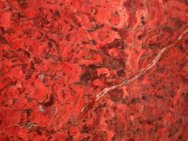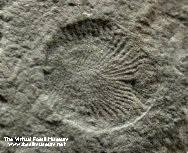Precambrian
Life
 Although
the Precambrian contains some seven-eighths of Earth's history,
its fossil record is poor,
with the majority of fossils being the stromatolites
that are often heavily metamorphosed or deeply buried. However,
preserved cells have been discovered at selective sites, such
as the 2.0 billion yar old Gunflint Formation. The earliest
life forms were prokaryotes (eubacteria
or archaea) that evolved
in the seas, possibly as early as 3.8 Ba. The first were
possibly chemotrophs existing in an anoxic world and producing
H2S Although
the Precambrian contains some seven-eighths of Earth's history,
its fossil record is poor,
with the majority of fossils being the stromatolites
that are often heavily metamorphosed or deeply buried. However,
preserved cells have been discovered at selective sites, such
as the 2.0 billion yar old Gunflint Formation. The earliest
life forms were prokaryotes (eubacteria
or archaea) that evolved
in the seas, possibly as early as 3.8 Ba. The first were
possibly chemotrophs existing in an anoxic world and producing
H2S or CO2, which were followed by photosynthetic cyanobacteria
before the end of the Archaean some 2.5 billion years ago.
When the Eukaryotes
(single-celled organisms with a nucleus) evolved through Endosymbiosis
is disputed, with claims as early as 3.4 billion years ago,
but with less equivocal fossils dating from 1.8 to .8 billion
yars ago. With the eukaryotes
comes
sexual reproduction, enabling genetic diversity and
or CO2, which were followed by photosynthetic cyanobacteria
before the end of the Archaean some 2.5 billion years ago.
When the Eukaryotes
(single-celled organisms with a nucleus) evolved through Endosymbiosis
is disputed, with claims as early as 3.4 billion years ago,
but with less equivocal fossils dating from 1.8 to .8 billion
yars ago. With the eukaryotes
comes
sexual reproduction, enabling genetic diversity and  the
concomitant ability to adapt to and survive environmental
changes.
Multi-celled, soft-bodied marine fossil organisms (the metazoans),
the so-called Ediacara fauna, are found in strata dating between
590 to
700 million years ago. The first mineralized fossils appear
after the Ediacaran, but before Cambrian begins at around 580
- 590
my;
they comprise
ambiguous parts, possibly denticles and plates and tubes of
unknown affinity and putative calcareous algae. Many of the
genes and the proteins they encode are found to be conserved
across geologic time from the Precambrian, especially those
involved in the most basic cellular functions. the
concomitant ability to adapt to and survive environmental
changes.
Multi-celled, soft-bodied marine fossil organisms (the metazoans),
the so-called Ediacara fauna, are found in strata dating between
590 to
700 million years ago. The first mineralized fossils appear
after the Ediacaran, but before Cambrian begins at around 580
- 590
my;
they comprise
ambiguous parts, possibly denticles and plates and tubes of
unknown affinity and putative calcareous algae. Many of the
genes and the proteins they encode are found to be conserved
across geologic time from the Precambrian, especially those
involved in the most basic cellular functions.
Precambrian
Fossils
 |
|
|
 |
|
|
|
|
|
|
|
|
|
|
|
|
|
|
|
|
|
|
|
|
|
|
|
|
Hox
Genes
The Hox genes that control
Metazoan development are highly conserved
|
|
|
|
|
|
|
|
|
|
|
|
|
|
|
|
|
|
|
|
|
|
|
|
|
|
|
|
|
|
























